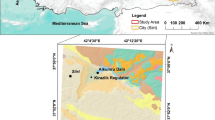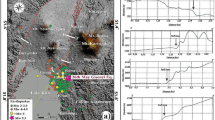Abstract
We present regional maps of earthquake-induced liquefaction hazard in Mexico considering the lateral or horizontal spreading displacement, as index, D LL . The methodology to prepare the liquefaction hazard maps consists of five steps: (1) identifying zones with soil deposits that are more susceptible to displaying liquefaction based on geologic available information at a 1:1,000,000 scale; (2) characterizing the seismic hazard as a set of stochastic events that collectively describe the hazard, compatible with the distribution of location, depth, frequencies, magnitudes and attenuation of the seismic strong ground motion; (3) employing a parametric method, based on empirical data, to estimate the demand of permanent ground deformation expected due to liquefaction (in this study, the lateral spreading displacement of the ground, D LL ) by event and for the site required; (4) characterizing the earthquake-induced liquefaction hazard as a set of stochastic events that describe the spatial distribution demand of liquefaction for each event; and (5) performing a probabilistic analysis of liquefaction hazard. The results of liquefaction hazard associated with return periods of 150 and 500 years are shown on maps of Mexico. Those maps are compared qualitatively with historical information collected from sites where, based on descriptions, the phenomenon of earthquake-induced liquefaction is seen to have occurred from the year 1593 to 2010. The results obtained in this study provide a first approximation to the liquefaction hazard zones in the country, in accordance with sites where historical evidence of liquefaction has been reported. In addition, the application could be important in land-use planning and urban development, particularly in regions with a historical certainty of earthquake-induced liquefaction, but with little or no geotechnical and/or geophysical studies. These maps can be used to locate zones where more in-depth studies are required to estimate, with less uncertainty, the potential for earthquake-induced liquefaction.








Similar content being viewed by others
References
Abrahamson N, Silva W (1997) Empirical response spectral attenuation relations for shallow crustal earthquakes. Seismol Res Lett 68(1):94–127
Aguilera-Serrano J (1888) Estudio de los fenómenos sísmicos del 3 de Mayo de 1887, Anales del Ministerio de Fomento de la República Mexicana, X, pp 5–56 (in Spanish)
Alcocer S, Durán R, Flores L, Gutiérrez C, Reyes C (2003) Preliminary observations on the Tecomán, Colima, Mexico, Earthquake of January 21, 2003. Reporte especial del sismo por parte de EERI-CENAPRED (in Spanish)
Anderson J, Simons R (1982) The Mexicali Valley earthquake of 9 June 1980. Earthq Eng Res Inst Newsl 16(3):73–105
Arroyo D, García D, Ordaz M, Alexander M, Singh S (2010) Strong ground-motion relations for Mexican interplate earthquakes. J Seismol 14:769–785
Bardet J, Tobita T, Mace N, Ju J (2002) Regional modeling of liquefaction-induced ground deformation. Earthq Spectra EERI 18(1):19–46
Bartlett S, Youd T (1995) Empirical prediction of liquefaction-induced lateral spread. J Geotechnical Eng ASCE 121(4):316–329
Boulanger R, Idriss I (2004) Evaluating the potential for liquefaction or cyclic failure of silts and clays. Report UCD/CGM-04/01, University of California, Davis, California
Bray J, Sancio R (2006) Assessment of the liquefaction susceptibility of fine-grained soils. J Geotech Geoenviron Eng 132(9):1165–1177
Casagrande A (1965) Role of the calculated risk in earthwork and foundation engineering. J Soil Mech Found Div ASCE 91(4):69–138
Castro G (1969) Liquefaction of sands. Harvard Soil Mechanics Series 81
Cetin K, Seed R, Der Kiureghian A, Tokimatsu K, Harder L, Kayen R, Moss R (2004) Standard penetration test-based probabilistic and deterministic assessment of seismic soil liquefaction potential. J Geotech Geoenviron Eng ASCE 130(12):1314–1340
Cornell CA (1968) Engineering seismic risk analysis. Bull Seismol Soc Am 58(5):1583–1606
Dawson A, Flores R, Arenas A (1977) Estudio de licuación de arenas en Chiapas. Instituto de Ingeniería, UNAM, Proyecto, vol 5182, pp 1–116 (in Spanish)
Dobry R, Alvarez L (1967) Seismic failures of Chilean tailing dams. J Soil Mech Found Div 93(SM6):237–260
DuBois S, Sbar M (1981) The 1887 earthquake in Sonora: analysis of regional ground shaking and ground failure. In: Proceedings of conference XIII, evaluation of regional seismic hazards and risk, (Santa Fe, New Mexico, August 25–27, 1980), edited by W. W. Hays and compiled by B. B. Charonnat, U.S. Geol. Surv. Open File Rep. 81–437, Reston, VA
EERI (Earthquake Engineering Research Institute) (2010) The Mw 7.2 El Mayor Cucapah (Baja California) earthquake of April 4, 2010. EERI Special Earthquake Report, pp 1–12
Esteva L (1967) Criterios para la construcción de espectros para diseño sísmico. 3er Simposio Panamericano de Estructuras, Caracas, Venezuela (in Spanish)
Esteva L (1970) Seismic risk and seismic design decisions. In: Hansen RJ (ed) Seismic design for nuclear power plants. MIT Press, Cambridge, pp 142–182
Figueroa J (1975) Sismicidad en Oaxaca. Instituto de Ingeniería, UNAM, México, No. 360 (in Spanish)
García V, Suárez G (1996) Los sismos en la historia de México. Fondo de Cultura Económica (FCE)-Universidad Nacional Autónoma de México (UNAM)-Centro de Investigación y Estudios Superiores en Antropología Social (CIESAS), México, 1 (in Spanish)
García D, Singh SH, Herráiz M, Ordaz M, Pacheco J (2005) Inslab earthquakes of central Mexico: peak ground-motion parameters and response spectra. Bull Seismol Soc Am 95(6):2272–2282
Glaser S (1994) Estimation of surface displacement due to earthquake excitation of saturated sands. Earthq Spectra 10(3):489–517
HAZUS (2003) HAZUS-MH technical manual. FEMA Federal Emergency Management Agency, Washington, DC
Huang Y, Yu M (2013) Review of soil liquefaction characteristics during major earthquakes of the twenty-first century. Nat Hazards 65(3):2375–2384
Idriss I, Boulanger R (2008) Soil liquefaction during earthquakes. Monograph, Earthquake Engineering Research Institute, Oakland
IG-II UNAM (1985) Informe y evaluación preliminar elaborado por el Instituto de Geofísica con la Colaboración del Instituto de Ingeniería, UNAM, http://www.ssn.unam.mx/website/jsp/Sismo85/sismo85_inf.htm
INEGI (Instituto Nacional de Estadística Geografía e Informática) (2010) http://www.inegi.org.mx/geo/contenidos/recnat/geologia/default.aspx, Escala 1:1,000,000
Ishihara K, Takatsu H (1979) Effects of over consolidation and K0 conditions on the liquefaction characteristics of sands. Soils Found 19(4):59–68
Jaime A (1980) Comportamiento del suelo y estructuras terreas del Valle de Mexicali. Sismo de junio 8, 1980. X Reunión Nacional de Mecánica de Suelos, Morelia, Michoacán (in Spanish)
Jaime A, Montañez L, Romo M, Arguello M (1979) Estudio de licuación del subsuelo del complejo industrial de fosforados Fertimex Lázaro Cárdenas Michoacán. Final Report (in Spanish)
Jaime A, Romo M, Montañez L (1981a) observed and predicted liquefaction of a sand stratum. In: International conference on recent advances in geotechnical earthquake engineering and soil dynamics, St. Louis, MO, EAU
Jaime A, Montañez L, Romo M (1981b) Liquefaction of the Enmedio Island soil deposits. In: International conference on recent advances in geotechnical earthquake engineering and soil dynamics, St. Louis, MO, EAU
James N, Sitharam T, Padmanabhan G, Pillai C (2014) Seismic microzonation of a nuclear power plant site with detailed geotechnical, geophysical and site effect studies. Nat Hazards 71(1):419–462
Juárez H, Guerrero J, Gama A, Withney R, Vera R. Hurtado F (1995) El sismo del 9 de octubre de 1995 en Manzanillo, Colima, 316–326 (in Spanish)
Kishida H (1966) Damage to reinforced concrete buildings in Niigata city with special reference to foundation engineering. Soil Found 6(1):71–88
Koutsourelakis S, Prévost J, Deodatis G (2002) Risk assessment of an interacting structure-soil system due to liquefaction. Earthq Eng Struct Dyn 31:851–879
Marsal R (1961) Behavior of a sandy uniform soil during the Jaltipán Earthquake, Mexico. In: Proceedings of the 5th international conference on soil mechanics and foundation engineering, París, Francia, pp 229–233
McGuire R (2008) Probabilistic seismic hazard analysis: early history. Earthq Eng Struct Dyn 37:329–338
Ohsaki Y (1966) Niigata earthquake, 1964 building damage and soil condition. Soil Found 6(2):14–37
Ohsaki Y (1969) The effects of local soil conditions upon earthquake damage. In: Proceedings of the seventh international conference on soil mechanics and foundations engineering, vol 3, pp 421–422
Ordaz M (2000) Seismic risk assessment methodology focused on earthquake insurance management. National University of Mexico, Mexico
Ordaz M, Aguilar A, Arboleda J (2007) CRISIS2007-Ver. 7.2: Program for Computing Seismic Hazard. Instituto de Ingeniería, UNAM, México
Ovando E (1996) Licuación de arenas.TGC Geotécnica, México, 55 pp (in Spanish)
Pathak S, Dalvi A (2013) Elementary empirical model to assess seismic soil liquefaction. Nat Hazards 69(1):425–440
Pestana J, Sancio R, Bray J, Romo M, Mendoza M, Moss R, Mayoral J, Seed R (1999) El sismo de Tehuacán del 15 de junio de 1999. CENAPRED (in Spanish)
Rauch A (1997) EPOLLS: an empirical method for predicting surface displacements due to liquefaction-induced lateral spreading in earthquakes. PhD dissertation, Virginia Polytechnic Institute and State University, Blacksburg, Va
Rauch A, Martin J (2000) EPOLLS Model for predicting average displacements on lateral spreads. J Geotech Geoenviron Eng ASCE 126(4):360–371
Reinoso E, Ordaz M (2001) Duration of strong ground motion during Mexican earthquakes in terms of magnitude, distance to the rupture are and dominant site period. Earthq Eng Struct Dyn 30(5):653–673
Rocha A (1982) Puerto industrial Lázaro Cárdenas Michoacán, IV. 4. Rellenos. Memorias de la XI Reunión Nacional de Mecánica de Suelos, Veracruz, Ver., 271–274 (in Spanish)
Santoyo E, Montañez L (1976) Información general acerca del subsuelo de 17 ciudades de México, 9. Mexicali, B.C.N. Memorias de la VIII Reunión Nacional de Mecánica de Suelos, Secretaria de Obras Publicas-Instituto de Ingeniería, Guanajuato, 2, 119–122 (in Spanish)
Schwartz D, Coppersmith (1984) Fault behavior and characteristic earthquakes: examples from the Wasatch and San Andreas Fault zones. J Geophys Res 89:5681–5698
Seed H, Idriss I (1971) Simplified procedure for evaluating soil liquefaction potential. J Soil Mech Found Div ASCE 97(SM9):1249–1273
Seed H, Idriss I (1981) Evaluation of liquefaction potential of sands deposits based on observations of performance in previous earthquakes. Session on in situ testing to evaluate liquefaction susceptibility, ASCE National Convention, St. Louis, MO, 81, 544, October (preprint)
Seed H, Lee K (1965) Studies of liquefaction of sands under cyclic loading conditions. Report TE-65-65. Department of Civil Engineering, University of California, Berkeley
Seed R, Cetin K, Moss R, Kammerer A, Wu J, Pestana J et al (2003) Recent advances in soil liquefaction engineering: a unified and consistent framework. 26th annual ASCE Los Angeles geotechnical spring seminar, Long Beach, California, Keynote presentation
Singh S, Rodriguez M, Esteva L (1983) Statistics of small earthquakes and frequency of occurrence of large earthquakes along the Mexican subduction zone. Bull Seismol Soc Am 73:1779–1796
Tanaka Y (2011) Damage and recoveries of Great East Japan Earthquake & Tsunami (GEJET). Bogotá, Colombia, Keynote presentation
Terzaghi K (1943) Theoretical soil mechanics. John Wiley & Sons, Nueva York
Trifunac M, Novikova E (1995) Duration of earthquake fault motion in California. Earthq Eng Struct Dyn 24(6):781–799
Vallejo L (2002) Ingeniería Geológica. Prentice Hall, Pearson Educación
Vipin K, Sitharam T, Anbazhagan P (2010) Probabilistic evaluation of seismic soil liquefaction potential based on SPT data. Nat Hazards 53(3):547–560
Wesnousky S (1994) The Gutenberg–Richter or characteristic earthquake distribution, which is it? Bull Seismol Soc Am 84:1940–1959
Xue X, Yang X (2014) Seismic liquefaction potential assessed by fuzzy comprehensive evaluation method. Nat Hazards 71(3):2101–2112
Youd T, Perkins D (1978) Mapping liquefactions-induced ground failure potential. J Geotech Eng Div ASCE 104(GT4):433–446
Youd T, Perkins D (1987) Mapping of liquefaction severity index. J Geotech Eng Div ASCE 113(11):1374–1393
Youd T, Hansen C, Bartlett S (2002) Revised multilinear regression equations for prediction of lateral spread displacement. J Geotech Geoenviron Eng ASCE 128(12):1007–1017
Author information
Authors and Affiliations
Corresponding author
Rights and permissions
About this article
Cite this article
Jaimes, M.A., Niño, M. & Reinoso, E. Regional map of earthquake-induced liquefaction hazard using the lateral spreading displacement index D LL . Nat Hazards 77, 1595–1618 (2015). https://doi.org/10.1007/s11069-015-1666-1
Received:
Accepted:
Published:
Issue Date:
DOI: https://doi.org/10.1007/s11069-015-1666-1




